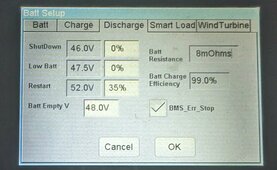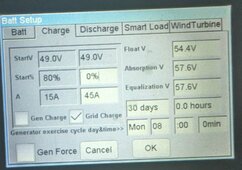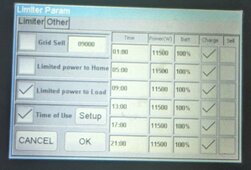Hey everyone! I was hoping I may be able to share the problem I'm experiencing with you folks, and see if you experts have any insight. For reference, here is my current setup:
- SolArk 15k Inverter/Charger
- 5x SOK 48v 100Ah batteries
- grid tied
- no solar (yet)
Basically I live in an area where power outages are super common. My batteries aren't lasting worth a damn, and my draw is not high. I only charge the batteries to 90%, and the BMS is set to shut down them down at 20%, so I'm not taxing the batteries. 3 outages in a row I've only gotten about 6 hours of battery backup.
--------------------------------
I've attached a collage of screenshots from the solark app. P-Grid displays a steady 0W because it's a power outage. Notice the SOC when compared against the time stamps.
05:47-05:52 displays a 20% drop in SOC....very bad.
05:52-06:02 displays a 1% drop in SOC...more normal, still worse than expected.
06:02-08:37 displays a 42% drop in SOC....very bad. Extra bad because the BMS is programmed to shut down at 20%, and the load during this period is no more than 200W at any time.
--------------------------------
Anyways here's some quick math. Let's round this up so we're at max draw for those 6 hours of standby time we're getting:
1500W x 6hours = 9kWh
I've got 5 batteries connected right now:
5 x 5120Wh = 25.6kWh
I only run the batteries between 20%-90%, so I'll subtract 30% of potential from the theoretical max capacity:
25.6kWh x 0.7 = 17,920Wh
So even with my very lenient math, the batteries are running at 50%....best case scenario. And that doesn't explain the extremely sharp/almost immediate drop from 63% to 43% SOC.
-------------------------------
I'm absolutely stumped. I think I've got dud batteries. I bought 6, and only 5 are in the system right now as #6 is getting a BMS replacement under warranty. Batteries are kept at room temperature
- SolArk 15k Inverter/Charger
- 5x SOK 48v 100Ah batteries
- grid tied
- no solar (yet)
Basically I live in an area where power outages are super common. My batteries aren't lasting worth a damn, and my draw is not high. I only charge the batteries to 90%, and the BMS is set to shut down them down at 20%, so I'm not taxing the batteries. 3 outages in a row I've only gotten about 6 hours of battery backup.
--------------------------------
I've attached a collage of screenshots from the solark app. P-Grid displays a steady 0W because it's a power outage. Notice the SOC when compared against the time stamps.
05:47-05:52 displays a 20% drop in SOC....very bad.
05:52-06:02 displays a 1% drop in SOC...more normal, still worse than expected.
06:02-08:37 displays a 42% drop in SOC....very bad. Extra bad because the BMS is programmed to shut down at 20%, and the load during this period is no more than 200W at any time.
--------------------------------
Anyways here's some quick math. Let's round this up so we're at max draw for those 6 hours of standby time we're getting:
1500W x 6hours = 9kWh
I've got 5 batteries connected right now:
5 x 5120Wh = 25.6kWh
I only run the batteries between 20%-90%, so I'll subtract 30% of potential from the theoretical max capacity:
25.6kWh x 0.7 = 17,920Wh
So even with my very lenient math, the batteries are running at 50%....best case scenario. And that doesn't explain the extremely sharp/almost immediate drop from 63% to 43% SOC.
-------------------------------
I'm absolutely stumped. I think I've got dud batteries. I bought 6, and only 5 are in the system right now as #6 is getting a BMS replacement under warranty. Batteries are kept at room temperature






